
- Home
- Travel Packages
- Top Destination
-
Travel Attraction
By Category
Top Attraction

- Travel Agents
- Car Rentals
- Hotels
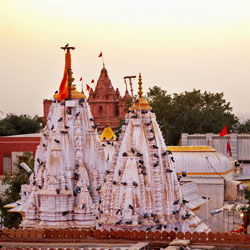
About Bhandeshwar Jain Temples, Bikaner History The Bhandeshwar Jain Temples in Bikaner are a group of beautifully crafted temples that date back to the 15th century. These temples were built during the rule of Maharaja Rai Singh, the sixth ruler of Bikaner. The intricate carvings and stunning architecture of the temples speak to the rich cultural and religious history of the region. Architecture and Design The Bhandeshwar Jain Temples are known for their exquisite architecture and design. The temples are made of red sandstone and feature intricate carvings, delicate sculptures, and elaborate lattice work. The interiors of the temples are adorned with beautiful paintings and frescoes that depict Jain teachings and mythology. Best Time to Visit While the Bhandeshwar Jain Temples can be visited throughout the year, the best time to visit is during the winter months from October to March when the weather is pleasant and cool. Cultural Significance The Bhandeshwar Jain Temples hold immense cultural significance for the Jain community as they are considered sacred places of worship. The temples are also significant for their historical importance and architectural beauty, attracting visitors from all over the world. Pilgrimage Practices Visitors to the Bhandeshwar Jain Temples can participate in various pilgrimage practices such as offering prayers, meditating, and performing rituals. Pilgrims often undertake a journey to the temples to seek spiritual enlightenment and blessings. Dress Code and Etiquette While visiting the Bhandeshwar Jain Temples, it is important to dress modestly and respectfully. Visitors should cover their shoulders and knees and remove their shoes before entering the temple premises. Silence and reverence should be maintained inside the temples to show respect for the religious practices. Activities and Experiences Visitors to the Bhandeshwar Jain Temples can engage in various activities and experiences such as attending religious ceremonies, exploring the intricate architecture, and learning about Jain teachings. The serene atmosphere of the temples provides a peaceful and reflective space for visitors. Art and Religious Symbols The Bhandeshwar Jain Temples are adorned with exquisite art and religious symbols that hold deep significance for the Jain community. The intricate carvings, paintings, and sculptures depict scenes from Jain mythology and teachings, creating a spiritual and aesthetic experience for visitors. Local Insights Local residents and guides at the Bhandeshwar Jain Temples can provide valuable insights into the history, architecture, and cultural significance of the temples. Visitors can learn about the traditions and practices of the Jain community and gain a deeper understanding of the spiritual heritage of the region.
Explore More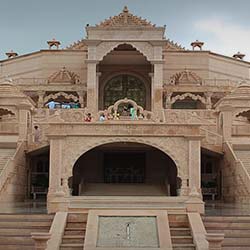
About Nareli Jain Temple, Ajmer The Nareli Jain Temple in Ajmer, Rajasthan is a magnificent architectural marvel that attracts numerous visitors and pilgrims from all over the country. This temple is dedicated to the Jain community and is known for its stunning design and religious significance. Let's delve into the history, architecture, and cultural practices associated with this iconic temple. History The construction of the Nareli Jain Temple began in the year 1997 under the guidance of the Anand Rishiji Maharaj. It took nearly 10 years to complete the temple complex, which is spread over 24 acres of land. The temple was built to provide a spiritual retreat for the Jain community and to showcase the rich cultural heritage of the religion. Architecture and Design The Nareli Jain Temple features a unique blend of modern and traditional architectural styles. The temple complex consists of 24 miniature temples, each dedicated to a different Jain Tirthankara. The central temple is adorned with intricate carvings, golden spires, and ornate domes, creating a mesmerizing sight for visitors. Best Time to Visit Visiting the Nareli Jain Temple in Ajmer is best during the winter months (October to March) when the weather is pleasant and ideal for sightseeing. Avoid visiting during the summer months (April to June) as the scorching heat can make it uncomfortable for outdoor activities. Cultural Significance The Nareli Jain Temple holds immense cultural significance for the Jain community as it serves as a place of worship, spiritual reflection, and community gatherings. Visitors can witness traditional Jain rituals, prayers, and ceremonies that are performed at the temple, offering a glimpse into the rich cultural heritage of the religion. Pilgrimage Practices Devotees visiting the Nareli Jain Temple often engage in various religious practices such as meditation, chanting of prayers, and offering of prayers to the deities. Pilgrims also participate in temple rituals, seek blessings from the priests, and make offerings to the Tirthankaras as a form of devotion and gratitude. Dress Code and Etiquette When visiting the Nareli Jain Temple, it is important to dress modestly and respectfully. Both men and women are expected to wear conservative clothing that covers their shoulders and knees. Remove footwear before entering the temple premises and maintain silence and decorum during prayer sessions. Activities and Experiences Visitors to the Nareli Jain Temple can participate in a range of activities and experiences that enrich their spiritual journey. Attend religious discourses, explore the temple complex, partake in religious ceremonies, and seek blessings from the deities. The serene surroundings and tranquil ambiance make it an ideal place for meditation and introspection. Art and Religious Symbols The Nareli Jain Temple is adorned with intricate sculptures, paintings, and carvings that depict scenes from Jain mythology and history. Religious symbols such as the Jain wheel, Swastika, and Om are prominently featured in the temple architecture, reflecting the spiritual beliefs and values of the Jain community. Local Insights Local residents of Ajmer can provide valuable insights into the history, cultural practices, and significance of the Nareli Jain Temple. Engage with local guides, priests, and artisans to gain a deeper understanding of the temple's architecture, religious rituals, and the influence of Jainism in the region.
Explore More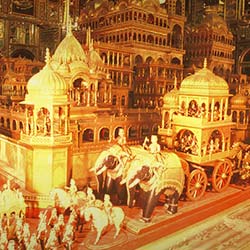
About Ajmer Jain Temple History, Architecture and Design The Ajmer Jain Temple, also known as Soniji Ki Nasiyan, is a stunning piece of architecture located in the city of Ajmer, Rajasthan. This temple was built in the late 19th century by the Jain merchant Seth Moolchand Soni. It is dedicated to Lord Rishabhanatha, who is considered to be the first Tirthankara of Jainism. The temple is known for its intricate designs and breathtaking architecture. The two-story structure is made entirely of red sandstone and features intricate carvings, sculptures, and paintings that depict various Jain philosophies and teachings. Best Time to Visit - The best time to visit the Ajmer Jain Temple is during the winter months, from October to March, when the weather is pleasant and perfect for exploring the temple and its surroundings. - The temple is also open throughout the year, so you can visit anytime you wish. Cultural Significance The Ajmer Jain Temple holds immense cultural significance for the Jain community. It is considered a sacred place of worship and pilgrimage for followers of Jainism. The temple is not only a religious site but also a cultural and historical landmark that showcases the rich heritage of Rajasthan. Pilgrimage Practices Visitors to the Ajmer Jain Temple can participate in various pilgrimage practices such as offering prayers, meditating, and performing rituals. Many devotees also bring offerings such as fruits, flowers, and sweets as a symbol of their devotion to Lord Rishabhanatha. Dress Code and Etiquette While visiting the Ajmer Jain Temple, it is important to dress modestly and respectfully. Visitors are required to cover their heads and remove their shoes before entering the temple premises. It is also considered polite to maintain silence and refrain from speaking loudly or engaging in disruptive behavior. Activities and Experiences Visitors to the Ajmer Jain Temple can engage in a variety of activities and experiences such as exploring the temple complex, admiring the intricate architecture, attending religious ceremonies, and learning about Jainism and its teachings. The temple also hosts various cultural events and festivals throughout the year that offer a glimpse into Jain traditions and practices. Art and Religious Symbols The Ajmer Jain Temple is adorned with beautiful artworks and religious symbols that hold deep spiritual significance for followers of Jainism. The temple's walls, ceilings, and pillars are adorned with intricate carvings, sculptures, and paintings that depict various Jain deities, symbols, and teachings. These artworks serve as a visual representation of Jain philosophy and spirituality. Local Insights Visiting the Ajmer Jain Temple offers visitors a unique opportunity to immerse themselves in the rich culture and heritage of Rajasthan. The temple is not only a place of worship but also a symbol of Jain traditions and values that have been passed down through generations. By exploring the temple and interacting with locals, visitors can gain valuable insights into the history, art, and spirituality of Jainism in the region.
Explore More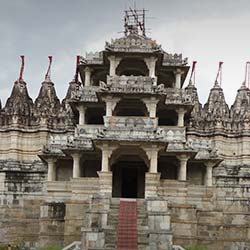
About the Mount Abu Jain Temples The Mount Abu Jain Temples are a group of ancient temples located in the picturesque hill station of Mount Abu in Rajasthan, India. These temples hold great cultural and religious significance for the Jain community and attract devotees and tourists from all over the world. The temples are known for their stunning architecture, intricate carvings, and serene surroundings, making them a must-visit destination for anyone interested in spirituality and history. History, Architecture, and Design The Mount Abu Jain Temples have a rich history dating back to the 11th century when they were built by the Parmar dynasty. The temples showcase a unique blend of Rajput and Jain architectural styles, with intricate marble carvings, domes, and pillars adorning the structures. The temples are dedicated to various Jain Tirthankaras and feature beautiful idols and sculptures that are a testament to the craftsmanship of the artisans of that time. Best Time to Visit - The best time to visit the Mount Abu Jain Temples is during the winter months from October to March when the weather is pleasant and conducive for exploring the temples and surrounding areas. - Avoid visiting during the monsoon season, from July to September, as the region experiences heavy rainfall and the temples may be slippery and inaccessible. Cultural Significance The Mount Abu Jain Temples hold immense cultural significance for the Jain community as they are considered sacred places of worship and pilgrimage. The temples are also important from a historical perspective as they showcase the rich heritage and architectural prowess of the region. Pilgrimage Practices Devotees visiting the Mount Abu Jain Temples engage in various pilgrimage practices such as offering prayers, performing rituals, and participating in religious ceremonies. The temples are considered a place of spiritual rejuvenation and enlightenment, and pilgrims often spend hours meditating and seeking blessings from the deities. Dress Code and Etiquette Visitors to the Mount Abu Jain Temples are required to dress modestly and adhere to the customs and traditions of the Jain community. It is recommended to wear conservative clothing that covers the shoulders and knees, remove shoes before entering the temples, and maintain a respectful demeanor while inside the sacred premises. Activities and Experiences While visiting the Mount Abu Jain Temples, visitors can partake in a variety of activities and experiences such as attending religious ceremonies, exploring the intricate carvings and sculptures, and soaking in the peaceful ambience of the temples. Additionally, visitors can also explore the surrounding areas of Mount Abu and indulge in nature walks and sightseeing. Art and Religious Symbols The Mount Abu Jain Temples are adorned with exquisite art and religious symbols that depict the teachings and principles of Jainism. The temples feature intricate carvings of Tirthankaras, Jain deities, and celestial beings, as well as symbols such as the swastika and lotus that hold deep spiritual significance in Jain culture. Local Insights Visitors to the Mount Abu Jain Temples can gain valuable insights into the local culture and traditions of the Jain community by interacting with the priests, attending religious discourses, and observing the daily rituals and practices followed at the temples. Local guides are also available to provide in-depth knowledge about the history and significance of the temples.
Explore More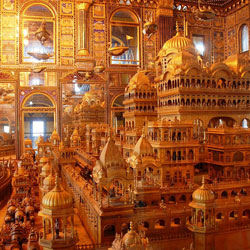
About Soniji Ki Nasiyan Soniji Ki Nasiyan, also known as the Ajmer Jain Temple, is a prominent religious site in Ajmer, Rajasthan, India. It is dedicated to Lord Rishabhanatha, who is the first Tirthankara of Jainism. The temple is renowned for its stunning architecture and intricate design, making it a must-visit attraction for tourists and pilgrims alike. History, Architecture, and Design The construction of Soniji Ki Nasiyan began in the late 19th century and was completed in 1865. The temple is adorned with intricate carvings, sculptures, and paintings that depict various Jain legends and teachings. The main prayer hall, known as the Swarna Nagari (City of Gold), is a marvel of architecture with its ornate gold-plated wooden structures and beautiful glasswork. Best Time to Visit - The best time to visit Soniji Ki Nasiyan is during the winter months from October to March when the weather is pleasant. - It is recommended to avoid visiting during the monsoon season from July to September due to heavy rainfall. Cultural Significance Soniji Ki Nasiyan holds great cultural significance for the Jain community as it is a place of worship and spiritual enlightenment. The temple is a symbol of Jain values such as non-violence, truthfulness, and compassion. Pilgrimage Practices Pilgrims visiting Soniji Ki Nasiyan usually participate in prayer ceremonies, offer donations, and seek blessings from the deities. It is a common practice to perform rituals such as lighting incense sticks, offering flowers, and chanting prayers. Dress Code and Etiquette Visitors are required to dress modestly and cover their shoulders and knees when entering Soniji Ki Nasiyan. It is also important to maintain silence and show respect for the religious customs and traditions observed at the temple. Activities and Experiences Visitors to Soniji Ki Nasiyan can explore the various prayer halls, admire the intricate artwork, and learn about Jain teachings and philosophy. The temple also has a museum that displays artifacts and relics related to Jain history and culture. Art and Religious Symbols The architecture of Soniji Ki Nasiyan is adorned with intricate carvings and sculptures that depict various Jain deities, symbols, and teachings. The temple's design is a reflection of Jain beliefs in non-violence, karma, and spiritual enlightenment. Local Insights Local guides at Soniji Ki Nasiyan can provide insights into the history, architecture, and significance of the temple. They can offer valuable information about Jainism, its rituals, and traditions, making the visit a truly enriching experience.
Explore More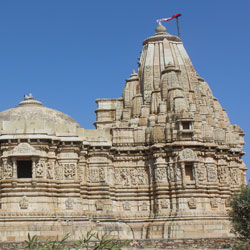
About Jain Temple, Chittorgarh History The Jain Temple in Chittorgarh has a rich history dating back to centuries. It is believed to have been built during the 11th century by the Solanki dynasty. The temple has witnessed various renovations and additions over the years, making it a significant historical and architectural landmark in the region. Architecture and Design The Jain Temple in Chittorgarh showcases exquisite architecture and intricate design elements. The temple features stunning sculptures, detailed carvings, and beautiful idols of Jain Tirthankaras. The structure reflects a blend of traditional Rajput and Jain architectural styles, making it a visually appealing sight for visitors. Best Time to Visit - The best time to visit Jain Temple, Chittorgarh is during the winter months from October to March when the weather is pleasant and ideal for sightseeing. - It is recommended to avoid visiting during the summer months from April to June as the temperatures can be extremely hot and uncomfortable. Cultural Significance The Jain Temple holds immense cultural significance for the Jain community and locals in Chittorgarh. It serves as a sacred place of worship and pilgrimage, attracting devotees from far and wide to seek blessings and spiritual solace. Pilgrimage Practices Devotees visiting the Jain Temple in Chittorgarh often engage in various pilgrimage practices such as offering prayers, performing rituals, and participating in religious ceremonies. It is a place where believers come to connect with their faith and deepen their spiritual bond with the divine. Dress Code and Etiquette Visitors are advised to dress modestly and respect the religious sanctity of the Jain Temple. It is customary to remove shoes before entering the temple premises and maintain a quiet and reverent demeanor while inside. Taking photographs or video recordings may be restricted, so it is essential to adhere to the guidelines and show reverence towards the sacred space. Activities and Experiences Visitors to the Jain Temple can indulge in a variety of activities and experiences to enhance their spiritual journey. They can participate in guided tours, attend religious ceremonies, explore the temple complex, and interact with local devotees to gain insights into Jain traditions and customs. Art and Religious Symbols The Jain Temple in Chittorgarh is adorned with exquisite artistry and religious symbols that hold deep spiritual significance for followers of Jainism. From intricate sculptures of Tirthankaras to symbolic motifs and depictions of Jain mythology, the temple serves as a visual feast for art enthusiasts and religious devotees alike. Local Insights Visiting the Jain Temple in Chittorgarh offers travelers a unique opportunity to immerse themselves in the local culture and traditions of the region. Interacting with local residents, exploring nearby markets, and tasting traditional cuisine can provide valuable insights into the vibrant heritage and lifestyle of the people in Chittorgarh.
Explore More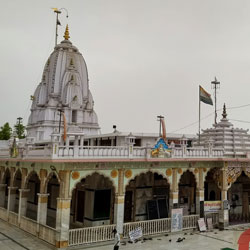
About Tijara Jain Temple History The Tijara Jain Temple, located in Alwar, is a significant pilgrimage site for the Jain community. The temple dates back to the 8th century and is dedicated to Lord Mahavira, the 24th Tirthankara of Jainism. It serves as a place of worship, reflection, and spiritual growth for followers of the Jain faith. Architecture and Design The Tijara Jain Temple is renowned for its stunning architecture and intricate design. The temple features exquisite carvings, ornate pillars, and beautiful sculptures that showcase the craftsmanship and artistry of ancient Jain architects. The temple's walls are adorned with colorful frescoes depicting scenes from Jain mythology, creating a serene and sacred atmosphere for visitors. Best Time to Visit The best time to visit the Tijara Jain Temple is during the winter months, from October to March, when the weather is pleasant and suitable for exploring the temple complex. Avoid visiting during the summer months, as temperatures can soar in Alwar, making it uncomfortable to roam around the temple. Cultural Significance The Tijara Jain Temple holds immense cultural significance for the Jain community, as it serves as a place of worship, meditation, and spiritual enlightenment. The temple is a symbol of Jain heritage and tradition, and its preservation is crucial for maintaining the rich cultural legacy of Jainism. Pilgrimage Practices Visitors are required to remove their shoes before entering the temple premises as a sign of respect. Pilgrims often perform rituals such as offering prayers, lighting incense sticks, and making offerings of flowers and fruits to Lord Mahavira. The temple complex also includes meditation halls and prayer rooms where devotees can engage in spiritual practices and seek inner peace. Dress Code and Etiquette Visitors are expected to dress modestly and appropriately when visiting the temple, covering their shoulders and knees out of respect for the sacredness of the site. Refrain from taking photographs inside the temple premises, as it is considered disrespectful to the sanctity of the place. Observe silence and maintain a calm and respectful demeanor while inside the temple to avoid disturbing others who are engaged in prayer and meditation. Activities and Experiences Visitors to the Tijara Jain Temple can participate in a variety of activities and experiences that enhance their spiritual journey and cultural understanding. Some of the activities include attending religious ceremonies, exploring the temple complex, interacting with Jain monks, and learning about Jain teachings and philosophy. Art and Religious Symbols The Tijara Jain Temple is adorned with intricate artwork, including intricate carvings, colorful frescoes, and symbolic sculptures that depict Jain deities, teachings, and stories. The temple's architecture is a blend of artistic creativity and spiritual symbolism, creating a visually stunning and spiritually uplifting environment for visitors. Local Insights Visiting the Tijara Jain Temple offers a unique opportunity to gain insights into Jain culture, traditions, and beliefs. Interacting with local devotees, attending religious ceremonies, and exploring the temple's architecture provide a deeper understanding of Jainism and its significance in the local community. Engaging with the local community allows visitors to appreciate the cultural richness and spiritual depth of Jain heritage in Alwar.
Explore More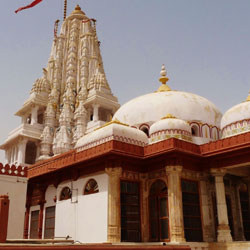
About Jain Temple Bhandasar, Bikaner History Jain Temple Bhandasar in Bikaner is a sacred place of worship for the Jain community. It was built by a wealthy merchant named Bhandasa Oswal in the 15th century. The construction of the temple took 45 years to complete, as it was meticulously designed and crafted with intricate marble carvings and vibrant frescoes. Architecture and Design The Jain Temple Bhandasar is renowned for its stunning architectural beauty. The temple is adorned with intricately carved marble columns, delicate filigree work, and colorful frescoes depicting Jain legends and stories. The temple's architecture is a perfect blend of Rajput and Mughal styles, making it a unique and visually stunning masterpiece. Best Time to Visit Winter months from October to March are the best time to visit Jain Temple Bhandasar in Bikaner, as the weather is pleasant and ideal for sightseeing. Cultural Significance The Jain Temple Bhandasar holds great cultural significance for the Jain community, as it is dedicated to the 5th Jain Tirthankara, Sumatinath. The temple is a symbol of Jain ideals such as non-violence, truth, and compassion. Pilgrimage Practices Pilgrims visiting the Jain Temple Bhandasar often perform rituals and prayers to seek blessings and spiritual enlightenment. Many followers also engage in meditation and reflection within the serene confines of the temple. Dress Code and Etiquette Visitors are required to dress modestly and cover their shoulders and legs while visiting the Jain Temple Bhandasar. It is customary to remove your shoes before entering the temple premises. Respectful behavior and silence are encouraged to maintain the sanctity of the temple. Activities and Experiences Visitors to Jain Temple Bhandasar can partake in various activities and experiences, such as exploring the exquisite architecture, admiring the intricate marble carvings, and soaking in the spiritual ambiance of the temple. Art and Religious Symbols The Jain Temple Bhandasar is adorned with beautiful artwork and religious symbols that symbolize Jain teachings and beliefs. Visitors can marvel at the detailed frescoes depicting Jain deities, Tirthankaras, and celestial beings. Local Insights Local guides at the Jain Temple Bhandasar can provide valuable insights into the history, architecture, and spiritual significance of the temple. Visitors can also learn about Jain customs, traditions, and rituals from the knowledgeable locals.
Explore MoreRoyal Rajasthan Tour - 7 Days
7 Days/ 6 Night
Bikaner - Jaipur - Jaisalmer - Jodhpur
3D - 2N Jaipur Tour Package
3 Days/ 2 Night
Jaipur
The Golden Triangle - 5 Nights 6 Days
6 Days/ 5 Night
Agra - Jaipur - New Delhi
4 Nights 5 Days Hills - Lakes Udaipur - Mount Abu Tour
5 Days/ 4 Night
Mount Abu - Udaipur